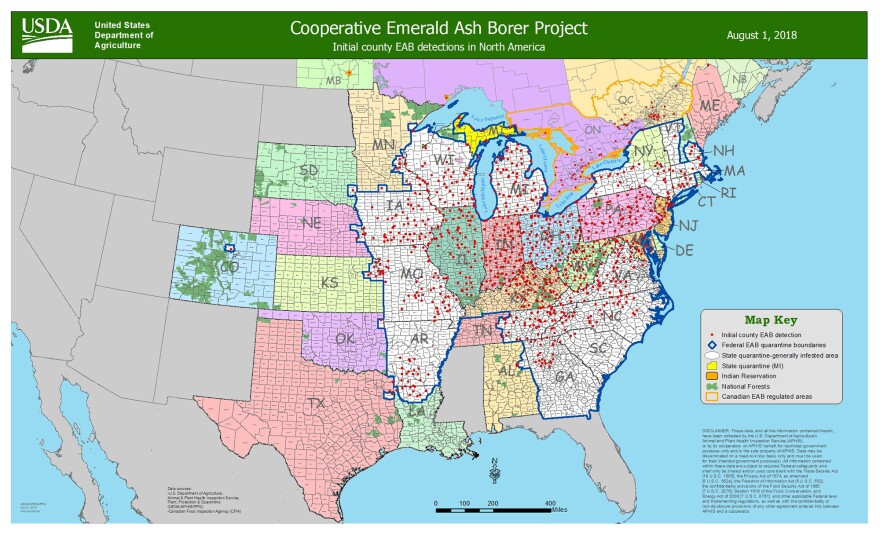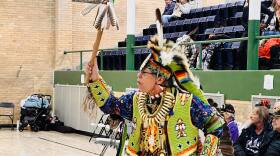Milwaukee has hundreds of thousands of trees, many of them in county parks.
Bay View resident Steve Ohly loves them, which is one reason he moved to Milwaukee. “I tend to be a tree hugger, really. But I do it in the morning when nobody’s around,” he says.
So, it’s no surprise that Steve lives across from a sea of trees in the heart of Bay View: Humboldt Park. That’s where I met him, to help answer his Beats Me question.
“What's the state of Milwaukee’s trees, I know some ash tree have come down in the last couple of years because of Emerald ash borer."
BEATS ME: What Questions Do You Have For WUWM's Beat Reporters?
Nearly 25 percent of the trees in all Milwaukee County parks are ash, according to Ramsey Radakovich, a certified arborist and Milwaukee County Parks deputy regional operations manager.

Ash trees are aggressively under attack by an invading beetle called the emerald ash borer. The beetle was first discovered near Detroit, Michigan, in the summer of 2002. Today, it’s found in 33 states and three Canadian provinces and has killed hundreds of millions of ash trees in North America.
And Milwaukee County is not exempt. “We’re losing ash trees,” Ramsey says.
The only way to stop the ash borer is to treat the tree – commonly by injecting a special insecticide into it.

Ramsey says five of Humboldt Park’s surviving 26 ash trees are being treated.
With so many trees to tend to, he’s forced to be selective. When deciding which ash tree to treat, safety comes first, followed by environmental function (the importance of the tree to its surroundings) and then aesthetics.
“To a lot of park goers, aesthetics is number one," Ramsey says. "But, ultimately, the way we look at it: If you can’t have a safe park because trees are falling down around you, aesthetics have to kind of sit."
When trees have to be removed, he says it’s important to replace them with a variety of species to strengthen the canopy’s resiliency.
“We’re taking into account global climate change so we’re looking at southern species that adapt — we’re trying to add more of those species,” Ramsey says. Those species include Chinkapin oak, Sycamore and Redbud.
But Ramsey isn’t able to replace every lost tree with a new one. While Friends Groups — groups that work to promote and enhance their neighborhood parks — help plant more trees, that's still not enough.
“Humboldt Park Friends we’ve done annual plantings around Earth Day and Arbor Day, but when you start taking out bigger trees even one tree to replace it is not going to make up for that,” he says.

Since 2016, in Humboldt Park alone, 56 trees had to be removed. The majority of them were ash trees.
Ash aren’t the only trees Ramsey tends, and there are times he bends his urban forestry rules.
We found that out when Beats Me question asker Steve Ohly wondered about a favorite tree in a park a mile east of here.
The European copper beach tree stood regally — from its massive gnarled trunk to its widely outstretched limbs — for well over a century.
Ramsey calls it one of Milwaukee County’s historic trees. It even had its own plaque proclaiming it Wisconsin’s largest specimen.

“It’s a champion copper beech that was recognized by the State of Wisconsin, but we started noticing a little bit of decline,” the arborist says.
Ramsey tried to save the tree,” We tried to do some remediation of the soil, some vertical mulching in there and some organic teas to try to revive it and see what it could do,” he says.
The efforts failed.
People who loved the tree, mourned it when it came down. But Ramsey says admirers got to take home chunks of the beech.
“Basically, what we decided to do was to cut off cookies for remembrance so people could make something and offered it to the community,” he says.
Ramsey can’t bring back that particular tree Steve loved. But if he were in charge of the universe, he would grant every tree a long, healthy life.
Tree lover Steve would do the same.
Have an environmental question you'd like WUWM's Susan Bence to investigate? Submit below.
_






